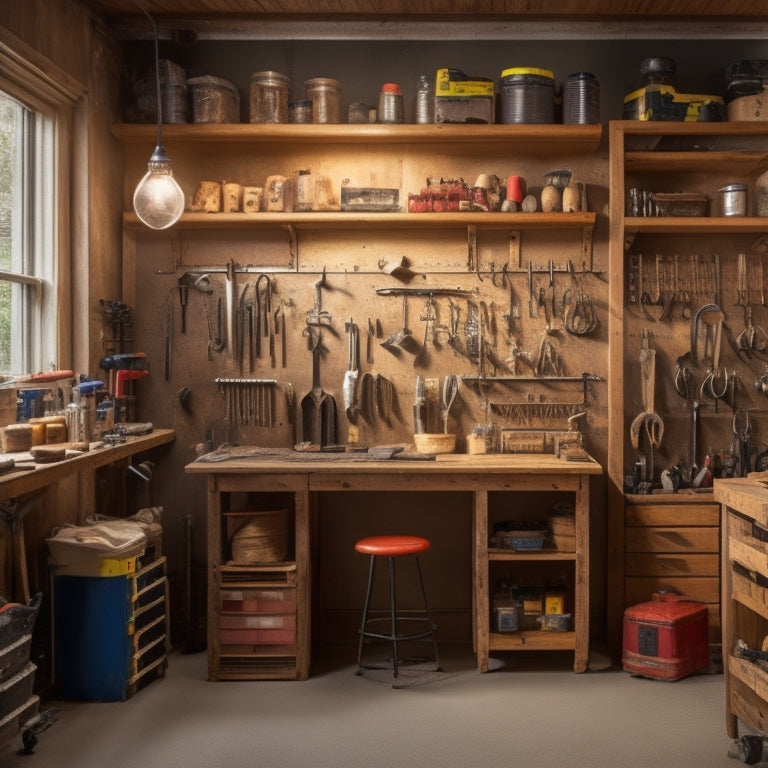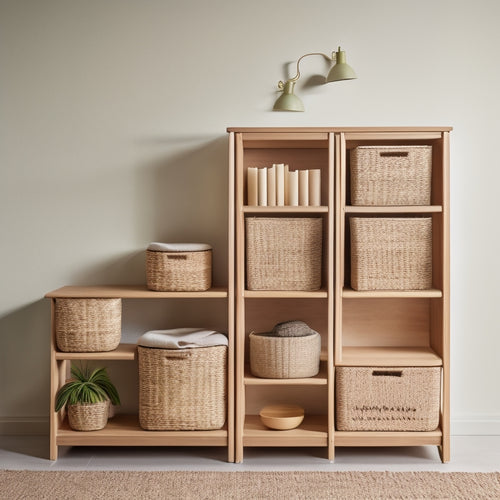
Streamline Your Workspace: Effective Tool Organization Systems
Share
You can greatly enhance your productivity and reduce stress by implementing a well-planned tool organization system that maximizes vertical space, labels and categorizes tools, and streamlines key storage and accessibility. By customizing your storage solutions, you'll enhance productivity, reduce wasted time, and decrease stress. Effective labeling and categorizing will help you quickly find the tools you need. A thoughtfully designed pegboard and centralized key hub will further simplify your workflow. Now, discover how to adapt these strategies to your unique workspace and start reaping the benefits of a more efficient you.
Key Takeaways
• Implementing a tool organization system saves time, reduces stress, and boosts productivity by assigning specific places for tools and supplies.
• Maximizing vertical space with wall-mounted shelves, hooks, and bins frees up floor space, reduces clutter, and increases workspace efficiency.
• Labeling and categorizing tools with clear labels, tool category labels, and color-coded organization enables quick access and reduces time searching for tools.
• Designing an effective tool pegboard with a layout for frequently used tools, accessibility, and efficiency reduces clutter and improves overall organization.
• Creating a centralized key hub with streamlined access, optimized tool management, and decreased misplacement promotes workspace structure and saves time searching for keys.
Customizing Tool Storage Solutions
What's holding you back from tackling that next project is likely a cluttered workspace, and customizing your tool storage solutions can be the key to enhancing your productivity. A disorganized workspace can lead to wasted time searching for tools, increased stress, and decreased motivation. By investing in personalized storage solutions, you can create an efficient workspace layout that works for you.
One effective way to achieve this is by utilizing customizable tool racks. These innovative storage solutions allow you to design a system that caters to your specific needs, ensuring that every tool has its designated place. This, in turn, enables you to quickly locate the tools you need, saving you time and energy.
Maximizing Vertical Space Usage
By incorporating wall-mounted shelves, hooks, and bins into your workspace design, you can effectively maximize your vertical space usage, freeing up precious floor space for more essential tools and equipment. This innovative storage solution allows you to make the most of your workspace, increasing workspace efficiency and reducing clutter.
Here are some vertical storage hacks to contemplate:
-
Install wall-mounted pegboards to hang frequently used tools, keeping them within easy reach while keeping the floor clear.
-
Use stackable bins and containers to store small items, such as nuts and bolts, or other small parts.
-
Mount shelves for less frequently used items, like seasonal decorations or infrequently used tools, to keep them out of the way.
- Hang a tool organizer near your workstation to keep your most essential tools within arm's reach.
Labeling and Categorizing Tools
When you're organizing your tools, establishing a system that makes sense to you is crucial. You'll want to begin by grouping similar tools together and giving each group a clear label, such as 'writing utensils' or 'crafting supplies'.
Tool Category Labels
You can greatly simplify your workspace by categorizing your tools into clear and distinct labels, allowing you to quickly identify and access the ones you need. This step is vital in creating an effective tool organization system. By labeling your tools, you can make sure that everything has a designated place, making it easier to maintain a tidy workspace.
Here are some essential categories to think about when creating your tool category labels:
-
Hand tools: hammers, screwdrivers, pliers, etc.
-
Power tools: drills, saws, sanders, etc.
-
Measuring tools: tape measures, levels, calipers, etc.
- Specialty tools: welding equipment, HVAC tools, plumbing tools, etc.
Color-Coded Organization
Organize your tools with a rainbow of efficiency by implementing a color-coded system that assigns a specific hue to each tool category, making it easy to identify and grab the right tool at a glance. This visual approach takes your tool organization to the next level, ensuring you can quickly find what you need and stay focused on the task at hand.
Assigning a unique color to each category, such as red for cutting tools or blue for measuring tools, creates a visual hierarchy that's easy to follow. You can use colored labels, stickers, or even paint to differentiate between tools.
This system not only saves time but also reduces frustration and errors. With a color-coded system, you'll be able to see at a glance which tool is which, even in a cluttered workspace.
Alphabetical Sorting
Building on the visual cues established by color-coding, alphabetical sorting takes your tool organization to the next level by categorizing and labeling each tool in a logical and systematic way. You'll be able to find what you need quickly and efficiently, saving you time and reducing frustration.
To implement alphabetical sorting, start by taking stock of your tool inventory and grouping similar items together. Then, assign a label to each tool or category, using a clear and concise naming convention.
Here are some tips to keep in mind:
-
Label each tool: Use a label maker to identify each tool, making it easy to find what you need.
-
Categorize by function: Group tools by their function or purpose, such as drilling, cutting, or measuring.
-
Use storage solutions: Implement storage solutions like bins, baskets, or drawers to keep tools organized and out of the way.
- Maintain your system: Set aside time each week to maintain your alphabetical sorting system, ensuring it remains organized and up-to-date.
Tool Pegboard Design Essentials
When designing a tool pegboard, consider the layout and placement of frequently used tools to maximize accessibility and efficiency. You want to make sure that your most-used tools are easily within reach, saving you time and energy. A well-designed pegboard layout can also help reduce clutter and improve overall organization.
Here are some tool pegboard design essentials to keep in mind:
| Tool Category | Pegboard Zone | Design Tip |
|---|---|---|
| Frequently Used | Easy Reach Zone | Place most-used tools at chest level for easy access |
| Heavy Tools | Lower Zone | Store heavy tools near the bottom to prevent strain |
| Small Tools | Upper Zone | Utilize upper pegs for small tools and accessories |
Small Business Storage Challenges
As you've optimized your tool pegboard for efficiency, you're likely to encounter another challenge in your small business: finding adequate storage for inventory, supplies, and equipment, which can quickly eat into your productivity and profitability. This is a common issue many small businesses face, and addressing it's vital to maintain workflow efficiency.
Effective inventory management is important to free up space and reduce clutter. Here are some common storage challenges you might face:
-
Insufficient shelving: Not having enough shelving space to store inventory, supplies, and equipment can lead to clutter and disorganization.
-
Inadequate labeling: Poor labeling of storage containers and shelves can make it difficult to find what you need, wasting valuable time.
-
Inefficient workspace layout: A poorly designed workspace layout can lead to congestion and reduce productivity.
- Overstocking: Overstocking can lead to wasted space and resources, making it necessary to implement a just-in-time inventory system.
Key Storage and Accessibility
When it comes to key storage and accessibility, you're likely tired of wasting time searching for misplaced keys or dealing with cluttered workspaces.
To combat this, you'll want to set up strategic points that allow you to quickly access and identify the keys you need.
Quick Access Points
Designate a central location for frequently used items, like keys and essential documents, to create a quick access point that saves you time and reduces clutter. This hub should be easily accessible and visible, ensuring you can grab what you need quickly.
Consider implementing the following solutions to optimize your quick access point:
-
Tool belt solutions: Keep frequently used tools attached to your belt, freeing up space in your workspace.
-
Mobile tool carts: Use carts with drawers or shelves to store items, making it easy to move them around as needed.
-
Tool drawer dividers: Organize your tool drawer with dividers, separating items into categories for easy retrieval.
- Magnetic tool holders: Attach magnetic holders to your workbench or cart, keeping frequently used tools within easy reach.
Visible Key Racks
By installing a visible key rack near your quick access point, you'll guarantee that your keys are always within sight and easily accessible, saving you time and frustration. This thoughtful key organization system allows you to quickly identify and grab the keys you need, streamlining your workflow and reducing stress.
Opt for a stylish key rack display that complements your workspace aesthetics. Choose from a variety of designs, such as modern key hooks or traditional key boards, to find one that suits your style.
A visible key rack also encourages accountability, as you'll be more likely to return keys to their designated spot after use. This habit helps maintain a clutter-free workspace and prevents misplaced or lost keys.
Centralized Key Hub
Your centralized key hub acts as a command center for key storage and accessibility, effectively managing your keys and freeing up valuable space in your workspace. By designating a specific area for key organization, you'll reduce clutter and increase productivity. This centralized station guarantees that you can quickly locate the keys you need, when you need them.
Here are four benefits of implementing a centralized key hub:
-
Streamlined access: With all your keys in one place, you'll save time searching for them.
-
Optimized tool management: A centralized key hub helps you keep track of which tools are currently in use and which are available.
-
Decreased misplacement: By storing keys in a designated area, you're less likely to misplace them.
- Improved organization: A centralized key hub promotes a sense of order and structure in your workspace.
Tool Organization for Efficiency
You'll save time and reduce frustration when you assign a specific place for each tool and implement a system to maintain that organization. This is where tool organization for efficiency comes in. By optimizing your tool storage, you'll be able to quickly find what you need, reducing downtime and increasing productivity.
Here are some efficiency tips to get you started:
| Tool Type | Storage Solution | Benefits |
|---|---|---|
| Hand tools | Pegboard with hooks | Easy access, space saving |
| Power tools | Custom shelving with dividers | Organization, protection from damage |
| Small parts | Clear storage bins with labels | Visible inventory, easy identification |
| Frequently used tools | Toolbox with compartments | Quick access, reduced clutter |
Adapting to Unique Workspaces
Every workspace is unique, and adapting your organizational system to its quirks and limitations is crucial to maintaining efficiency and productivity. As you tailor your tool organization system to your specific workspace, consider the following key factors:
-
Assess your space constraints: Identify areas where you can optimize storage and workflow. This might involve investing in portable storage solutions or adopting a minimalist workspace design.
-
Leverage digital organization tools: Digital tools can help you stay organized and focused, even in the most unconventional workspaces. Explore digital options for task management, note-taking, and collaboration.
-
Prioritize ergonomic tool placement: Guarantee that frequently used tools are placed within easy reach, reducing strain and discomfort. This can boost your energy levels and overall job satisfaction.
- Embrace flexibility: Be prepared to adjust your organizational system as your workspace evolves. Remain open to new ideas and solutions that can help you stay efficient and productive.
Measuring ROI on Tool Storage
Four out of five professionals struggle to quantify the financial benefits of their tool storage investments, leaving them wondering if their organizational efforts are truly paying off. You're not alone if you're unsure how to measure the return on investment (ROI) of your tool storage solutions.
Conducting a cost analysis can help you identify areas where your storage solutions are saving you money. For instance, are you reducing the time spent searching for tools, or minimizing the costs associated with lost or damaged equipment?
To measure ROI, start by tracking the efficiency of your organization systems. Implement efficiency tracking methods, such as timing how long it takes to complete tasks or monitoring the number of tools lost or damaged. This data will help you understand how your storage solutions are impacting your bottom line.
Frequently Asked Questions
How Often Should I Clean and Maintain My Tool Organization System?
'As you wonder how often to clean and maintain your tool organization system, remember that a regular maintenance schedule is key to accessing its benefits, ensuring your system's longevity and saving you time and frustration in the long run.'
Can I Use DIY Tool Organization Solutions for Heavy Machinery?
You can create DIY solutions for organizing heavy machinery, but make sure they're sturdy enough to support industrial equipment; consider consulting experts or engineers to guarantee safety and efficiency in your customized system.
Are Tool Organization Systems Suitable for Small or Home Offices?
You'll be surprised to know that 80% of employees waste time searching for misplaced items daily! In small or home offices, tool organization systems are perfect for space optimization and functionality, offering cost-effective solutions that blend aesthetics with productivity.
How Do I Prevent Tool Theft in a Shared Workspace?
To prevent tool theft in a shared workspace, you'll want to implement security measures like labeling tools, assigning responsibility, and installing cameras, ensuring everyone's accountable and tools are protected.
Can I Customize Tool Organization Systems for Left-Handed Workers?
You can easily customize tool organization systems to accommodate left-handed workers by incorporating left-handed adaptations and ergonomic solutions, such as reversed tool holders and angled work surfaces, to enhance their workflow and comfort.
Related Posts
-

Open Storage Bins for Shelving Units
You need open storage bins that integrate seamlessly with your shelving units to boost your organization, productivit...
-

Top 5 Small Tool Organizers for Your Workshop
You're looking to optimize your workshop's efficiency with high-quality small tool organizers. Compact storage soluti...
-

Heavy-Duty Commercial Rolling Shelving Racks
You need heavy-duty commercial rolling shelving racks that optimize your storage capacity, streamline operations, and...


